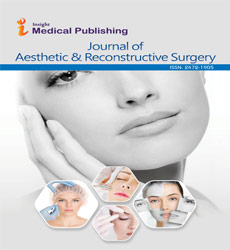The Transformative Power of Laser Resurfacing for the Aging Face
Jason Cook
Published Date: 2025-04-24Jason Cook*
Department of Plastic Surgery, Universidad Católica de Honduras, Tegucigalpa, Honduras
- *Corresponding Author:
- Jason Cook
Department of Plastic Surgery, Universidad Católica de Honduras, Tegucigalpa, Honduras
E-mail: jasoncook.spcboc@gamil.com
Received date: April 23, 2024, Manuscript No. IPARS-24-18959; Editor assigned date: April 25, 2024, PreQC No. IPARS-24-18959 (PQ); Reviewed date: May 09, 2024, QC No. IPARS-24-18959; Revised date: April 17, 2025, Manuscript No. IPARS-24-18959 (R); Published date: April 24, 2025, DOI: 10.36648/2472-1905.11.2.100
Citation: Cook J (2025) The Transformative Power of Laser Resurfacing for the Aging Face. J Aesthet Reconstr Surg Vol:11 No:2
Description
As we age, the skin undergoes various changes, including loss of elasticity, fine lines, wrinkles, and uneven pigmentation. While aging is a natural process, many individuals seek ways to rejuvenate their appearance and restore a more youthful look. Laser resurfacing has emerged as a popular and effective technique for addressing these concerns, offering remarkable results with minimal downtime.
Laser resurfacing works by delivering concentrated beams of light energy to the skin's surface, precisely targeting and removing damaged or aged skin cells layer by layer. This process stimulates the body's natural healing response, promoting the production of new collagen and elastin fibers, which are essential for firm, smooth, and youthful-looking skin.
One of the key advantages of laser resurfacing is its versatility. It can effectively treat a range of aging-related issues, including wrinkles, fine lines, age spots, sun damage, and uneven skin texture. Additionally, it can improve skin tone and tighten lax skin, providing comprehensive rejuvenation for the face.
There are two main types of laser resurfacing: ablative and non-ablative. Ablative lasers remove thin layers of skin, offering more dramatic results but requiring a longer recovery time. Non-ablative lasers, on the other hand, stimulate collagen production without damaging the skin's surface, resulting in less downtime but may require multiple treatments for optimal results.
Advancements in laser technology have led to the development of fractionated lasers, which deliver laser energy in a pixelated pattern, targeting only a fraction of the skin's surface while leaving surrounding tissues intact. This approach allows for faster healing and reduces the risk of complications compared to traditional ablative lasers.
Despite its effectiveness, laser resurfacing is not without risks. Potential side effects may include temporary redness, swelling, itching, and changes in skin pigmentation. It is essential to consult with a qualified and experienced dermatologist or plastic surgeon to determine the most suitable treatment approach based on individual skin type, concerns, and desired outcomes.
Conclusion
In conclusion, laser resurfacing offers a safe and effective solution for addressing the signs of aging and rejuvenating the face. With its ability to improve skin texture, tone, and firmness, it has become a cornerstone of modern aesthetic medicine, empowering individuals to look and feel their best at any age.
Open Access Journals
- Aquaculture & Veterinary Science
- Chemistry & Chemical Sciences
- Clinical Sciences
- Engineering
- General Science
- Genetics & Molecular Biology
- Health Care & Nursing
- Immunology & Microbiology
- Materials Science
- Mathematics & Physics
- Medical Sciences
- Neurology & Psychiatry
- Oncology & Cancer Science
- Pharmaceutical Sciences
